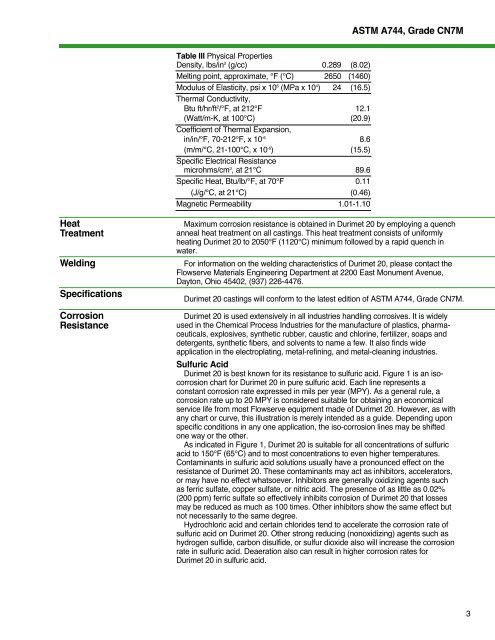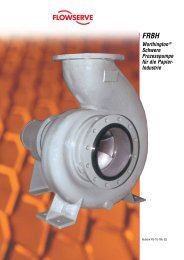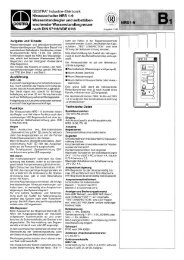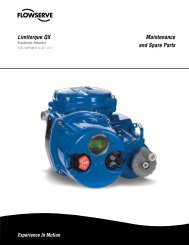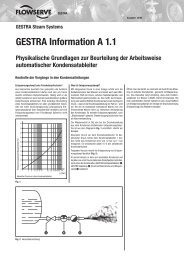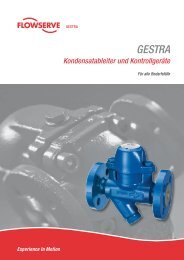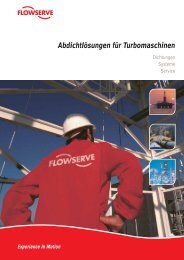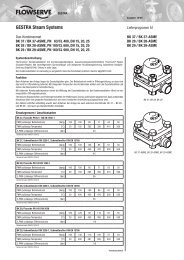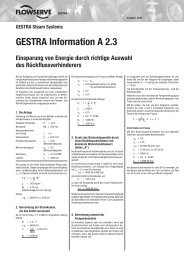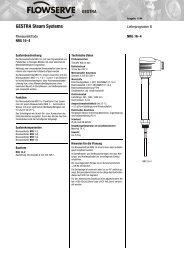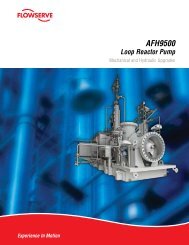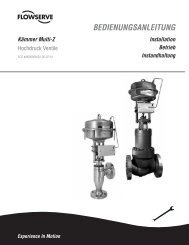Durimet 20 - Flowserve Corporation
Durimet 20 - Flowserve Corporation
Durimet 20 - Flowserve Corporation
Create successful ePaper yourself
Turn your PDF publications into a flip-book with our unique Google optimized e-Paper software.
Table III Physical Properties<br />
Density, lbs/in3 (g/cc) 0.289 (8.02)<br />
Melting point, approximate, °F (°C) 2650 (1460)<br />
Modulus of Elasticity, psi x 106 (MPa x 104 )<br />
Thermal Conductivity,<br />
24 (16.5)<br />
Btu ft/hr/ft2/ ° F,<br />
at<br />
212°<br />
F<br />
12.<br />
1<br />
( Watt/<br />
m-K,<br />
at<br />
100°<br />
C)<br />
Coefficient of Thermal Expansion,<br />
( <strong>20</strong>.<br />
9)<br />
in/in/°F, 70-212°F, x 10-6 8.6<br />
(m/m/°C, 21-100°C, x 10-6 )<br />
Specific Electrical Resistance<br />
(15.5)<br />
microhms/cm3, at<br />
21°<br />
C<br />
89.<br />
6<br />
Specific Heat, Btu/lb/°F, at 70°F 0.11<br />
( J/<br />
g/<br />
° C,<br />
at<br />
21°<br />
C)<br />
( 0.<br />
46)<br />
Magnetic<br />
Permeability<br />
1.<br />
01-1.<br />
10<br />
ASTM A744, Grade CN7M<br />
Heat Maximum corrosion resistance is obtained in <strong>Durimet</strong> <strong>20</strong> by employing a quench<br />
Treatment anneal heat treatment on all castings. This heat treatment consists of uniformly<br />
heating <strong>Durimet</strong> <strong>20</strong> to <strong>20</strong>50°F (11<strong>20</strong>°C) minimum followed by a rapid quench in<br />
water.<br />
Welding For information on the welding characteristics of <strong>Durimet</strong> <strong>20</strong>, please contact the<br />
<strong>Flowserve</strong> Materials Engineering Department at 2<strong>20</strong>0 East Monument Avenue,<br />
Dayton, Ohio 45402, (937) 226-4476.<br />
Specifications<br />
<strong>Durimet</strong> <strong>20</strong> castings will conform to the latest edition of ASTM A744, Grade CN7M.<br />
Corrosion <strong>Durimet</strong> <strong>20</strong> is used extensively in all industries handling corrosives. It is widely<br />
Resistance used in the Chemical Process Industries for the manufacture of plastics, pharmaceuticals,<br />
explosives, synthetic rubber, caustic and chlorine, fertilizer, soaps and<br />
detergents, synthetic fibers, and solvents to name a few. It also finds wide<br />
application in the electroplating, metal-refining, and metal-cleaning industries.<br />
Sulfuric Acid<br />
<strong>Durimet</strong> <strong>20</strong> is best known for its resistance to sulfuric acid. Figure 1 is an isocorrosion<br />
chart for <strong>Durimet</strong> <strong>20</strong> in pure sulfuric acid. Each line represents a<br />
constant corrosion rate expressed in mils per year (MPY). As a general rule, a<br />
corrosion rate up to <strong>20</strong> MPY is considered suitable for obtaining an economical<br />
service life from most <strong>Flowserve</strong> equipment made of <strong>Durimet</strong> <strong>20</strong>. However, as with<br />
any chart or curve, this illustration is merely intended as a guide. Depending upon<br />
specific conditions in any one application, the iso-corrosion lines may be shifted<br />
one way or the other.<br />
As indicated in Figure 1, <strong>Durimet</strong> <strong>20</strong> is suitable for all concentrations of sulfuric<br />
acid to 150°F (65°C) and to most concentrations to even higher temperatures.<br />
Contaminants in sulfuric acid solutions usually have a pronounced effect on the<br />
resistance of <strong>Durimet</strong> <strong>20</strong>. These contaminants may act as inhibitors, accelerators,<br />
or may have no effect whatsoever. Inhibitors are generally oxidizing agents such<br />
as ferric sulfate, copper sulfate, or nitric acid. The presence of as little as 0.02%<br />
(<strong>20</strong>0 ppm) ferric sulfate so effectively inhibits corrosion of <strong>Durimet</strong> <strong>20</strong> that losses<br />
may be reduced as much as 100 times. Other inhibitors show the same effect but<br />
not necessarily to the same degree.<br />
Hydrochloric acid and certain chlorides tend to accelerate the corrosion rate of<br />
sulfuric acid on <strong>Durimet</strong> <strong>20</strong>. Other strong reducing (nonoxidizing) agents such as<br />
hydrogen sulfide, carbon disulfide, or sulfur dioxide also will increase the corrosion<br />
rate in sulfuric acid. Deaeration also can result in higher corrosion rates for<br />
<strong>Durimet</strong> <strong>20</strong> in sulfuric acid.<br />
3


